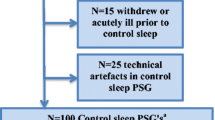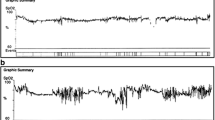Summary
The effect of a 24-h controlled-release (CR) preparation of theophylline (Th) on nocturnal arterial oxygen saturation (SaO2) and sleep quality has been evaluated in 7 patients with advanced chronic obstructive pulmonary disease (COPD) in a double-blind cross-over experiment; median values: age 61 y; PaO2 8.0 kPa; PaCO2 5.8 kPa.
During treatment with 450–900 mg Th in the evening, morning plasma drug levels ranged from 5.2–12.9 µg·ml−1. During Th and placebo treatment, the median evening FEV1 was 0.45 l and 0.46 l, respectively, and the morning FEV1 was 0.53 l and 0.41 l.
Sleep was monitored by whole-night polysomnographic recording of oximetric SaO2, airflow, respiratory and body movements (static charge sensitive bed), eye movements and submental electromyogram.
There was no significant difference between Th and placebo in sleep quality. Th treatment was associated with a marginal improvement in nocturnal oxygenation in most of the patients; the average nocturnal SaO2 ranged from 84.4%–92.8% during Th and from 82.2–90.5% during placebo treatment, respectively.
Only in the morning, during the last 2 h in bed, was the slight difference in SaO2 statistically significant in favour of Th.
It is concluded that a moderate dose of CR-theophylline did not alter the sleep quality or substantially improve nocturnal oxygenation in patients with advanced COPD and mild to moderate day-time hypoxaemia.
Similar content being viewed by others
References
Douglas NJ, Calverley PMA, Legget RJE, Brash HM, Flenley DC, Brezinova V (1979) Transient hypoxemia during sleep in chronic bronchitis and emphysema. Lancet 1: 1–4
Wynne JW, Block AJ, Hemenway J, Hunt LA, Flick MR (1979) Disordered breathing and oxygen desaturation during sleep in patients with chronic obstructive lung disease (COLD). Am J Med 66: 573–579
Catterall JR, Calverley PMA, MacNee W (1985) Mechanisms of transiet nocturnal hypoxemia in hypoxic chronic bronchitis and emphysema. J Appl Physiol 59: 1698–1703
Douglas NJ, Flenley DC (1990) Breathing during sleep in patients with chronic obstructive pulmonary disease. State of the art. Am Rev Respir Dis 141: 1055–1070
Fletcher EC, Luckett RA, Miller T, Costarangos C, Kutka N, Fletcher JG (1989) Pulmonary vascular hemodynamics in chronic lung disease patients with and without oxyhemoglobin desaturation during sleep. Chest 95: 757–764
Dull WL, Alexander MR (1984) Theophylline in stable chronic airflow obstruction. Arch Intern Med 144: 2399–2401
Hill NS (1988) The use of theophylline in “irreversible” chronic obstructive pulmonary disease — an update. Arch Intern Med 148: 2579–2584
Rhind GB, Connaughton JJ, McFie J, Douglas NJ, Flenley DC (1985) Sustained release choline theophyllinate in nocturnal asthma. BMJ 291: 1605–1607
Viljanen A (1982) Reference values for spirometric, pulmonary diffusing capacity and body plethysmographic studies. Scand J Clin Invest 42 [Suppl 159]: 1–50
Brander PE, Sovijärvi ARA, Salmi T, Hakulinen A, Poppius H (1990) Nocturnal oxygen saturation and body movements in asthmatics treated with controlled-release preparations of theophylline or terbutaline. Eur J Clin Pharmacol 39: 117–121
Salmi T, Brander PE (1989) Computerized polysomnographic recording and analysis in patients with COPD. Eur Respir J 2 [Suppl 8]: 796s
Salmi T, Telakivi T, Partinen M (1989) Evaluation of automatic analysis of SCSB, airflow and oxygen saturation signals in patients with sleep related apneas. Chest 96: 255–261
Svanborg E, Larsson H, Carlsson-Nordlander B, Pirskanen R (1990) A limited diagnostic investigation for obstructive sleep apnea syndrome. Oximetry and static charge sensitive bed. Chest 98: 1341–1345
Mordelet-Dambrine M, Baglin J-Y, Roux A, Dusser D, Flouvat B, Huchon G (1986) Comparison between theophylline analysis by nephelometric inhibition immunoassay and high performance liquid chromatography. Ther Drug Mon 8: 106–110
Lam A, Newhouse MT (1990) Management of asthma and chronic airflow limitation. Are methylxanthines obsolete? Chest 98: 44–52
DalNegro R, Turco R, Pomari C, Cordaro CI (1987) Clinical use of controlled-release theophylline in chronic airways obstruction. J Int Med Res 15: 391–396
Chrystyn H, Mulley BA, Peake MD (1988) Dose response relation to oral theophylline in severe chronic obstructive airways disease. BMJ 297: 1506–1510
Rogers RM, Owens GR, Pennock BE (1985) The pendulum swings again. Toward a rational use of theophylline. Chest 87: 280–282
Karttunen P, Tukiainen H, Nykänen S, Saano V (1985) Nighttime pharmacokinetics of once a day theophylline: a steady state comparison of three preparations. Int J Clin Pharmacol Ther Toxicol 23: 161–165
Ebden P, Vathenen AS (1987) Does aminophylline improve nocturnal hypoxia in patients with chronic airflow obstruction? Eur J Respir Dis 71: 384–387
Berry RB, Desa MM, Branum JP, Light RW (1991) Effect of theophylline on sleep and sleep-disordered breathing in patients with chronic obstructive pulmonary disease. Am Rev Respir Dis 143: 245–250
Brezinova V, Catterall JR, Douglas NJ, Calverley PMA, Flenley DC (1982) Night sleep of patients with chronic ventilatory failure and age matched controls: number and duration of the EEG episodes of intervening wakefulness and drowsiness. Sleep 5: 123–130
Fleetham J, West P, Mezon B, Conway W, Roth T, Kryger M (1982) Sleep, arousals, and oxygen desaturation in chronic obstructive pulmonary disease. The effect of oxygen therapy. Am Rev Resp Dis 125: 429–433
Martin RJ, Cicutto LC, Ballard RD, Goldenheim PD, Cherniak RM (1989) Circadian variations in theophylline concentrations and the treatment of nocturnal asthma. Am Rev Respir Dis 139: 475–478
Zwillich CW, Neagley SR, Cicutto L, White DP, Martin RJ (1989) Nocturnal asthma therapy. Inhaled biltorterol versus sustained-release theophylline. Am Rev Respir Dis 139: 470–474
Alihanka J (1982) Sleep movements and associated autonomic nervous activities in young male adults. Acta Physiol Scand Suppl 511: 1–85
Salmi T, Leinonen L (1986) Automatic analysis of sleep records with static charge sensitive bed. EEG Clin Neurophysiol 64: 84–87
Author information
Authors and Affiliations
Rights and permissions
About this article
Cite this article
Brander, P.E., Salmi, T. Nocturnal oxygen saturation and sleep quality in patients with advanced chronic obstructive pulmonary disease during treatment with moderate dose CR-theophylline. Eur J Clin Pharmacol 43, 125–129 (1992). https://doi.org/10.1007/BF01740657
Received:
Accepted:
Issue Date:
DOI: https://doi.org/10.1007/BF01740657




